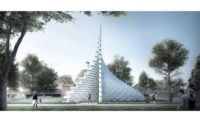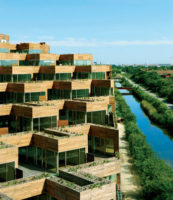“Designing sustainably and designing resiliently is not just more homework for architects and engineers,” said Bjarke Ingels at the closing plenary of Greenbuild 2016 Friday afternoon. “If embraced at the core of design efforts, it can enhance and expand our design vocabularies.” The founder of BIG explored this idea throughout his keynote address, using several of his firm’s project as case studies.
Drawing on ideas from Bernard Rudofsky’s 1964 book Architecture without Architects, which focuses on vernacular architecture, Ingels noted that Modernism arrived with the advent of building engineering. “Suddenly, the architecture didn't do anything,” said Ingels: electric lights supplanted daylighting, and mechanical ventilation replaced the need for windows. Essentially, he asserted, buildings became “boring [boxes], tube-fed by a gas guzzling machine room.”
But as technological advances allow designers to calculate building performance before they’re built, Ingels said an idea he calls Vernacular 2.0 is taking root. “Instead of ‘architecture without architects,’ you could almost call this ‘engineering without engines,’ ” he said, drawing cheers from the audience. “If we can put more performance into the bones of the building, we can actually take that performance out of the machine room and invest those resources into making better and more beautiful buildings.”
Ingels took the Greenbuild audience on a “safari” of his firm’s recent work, starting with the design for Shenzhen Energy Company’s headquarters in China. The geometry of the building’s facade, which is folded “like a pleated dress,” minimizes sun exposure to reduce energy consumption by one third. Likewise, the orientation of BIG’s Hualien Residences on the east coast of Taiwan allows for expansive glazing on the north and south faces of the mountain-like complex with minimal infiltration of direct sunlight, while landscaped roofs lower temperatures on balconies by four to five degrees—a benefit which helped the features survive value engineering.
Meanwhile, at BIG’s Museum of the Human Body in Montpellier, France, louvers take on an organic, thumbprint-like orientation thanks to a program which calculated their ideal arrangement on the undulating glass walls. And for a museum near the headquarters of Swiss watchmaker Audemars Piguet, the architects devised a coiled layout that blends into the landscape and recalls the inner-workings of a watch.
“What makes the building look different is also what makes it perform differently,” Ingels said of these examples. “It's not just an add-on—it becomes an intrinsic part of the building itself.”
Asked by incoming U.S. Green Building Council COO Mahesh Ramanujam what the next 20 years of architecture might hold, Ingels spoke of new materials and technologies, like graphene and 3D printing, before turning his gaze farther afield… to Mars. “We architects and engineers are going to have a lot of really powerful tools to play with in the next couple of decades,” he said. “Maybe we spend the next two decades practicing on earth—and then we take it to the next planet.
















Post a comment to this article
Report Abusive Comment